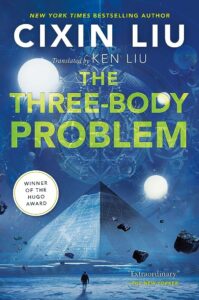
Within the genre of science fiction, readers will sometimes label stories as either “soft” or “hard” science fiction. “Soft” sci-fi are stories where the narrative uses futuristic science, such as interstellar travel, as plot devices but go easy on the explanations of how the science actually works. It all just works, or breaks down, for the sake of the plot. In contrast, “hard” science fiction stories are narratives which use real and/or theoretical science as the basis of the plot, often giving readers detailed explanations about how the science works. The Three-Body Problem, originally published in 2006 in China by Cixin Liu, is very much a “hard” sci-fi novel. It was later expertly translated into English by Ken Liu in 2014. And I mean expert, because The Three-Body Problem does not take prisoners and I enjoyed every second of it.
The Three-Body Problem is a sci-fi story about Ye Wenjie, the daughter of a disgraced “reactionary” physicist who becomes involved in a secret government project searching for extraterrestrial life during the Cultural Revolution in 1960s China. It is also a sci-fi story set during a near future China in which another scientist, Wang Maio, pushes the limits of nanotechnology and plays a virtual reality video games called “Three Body”, a game about complex astrological and mathematical problems which requires a full-body suit that simulates the temperature and gravitational pressure of the game’s world. It is a novel about a conspiracy which spans light years, about the consequences of grief and despair, and the intersection of science and politics. It’s a difficult book to explain, because The Three-Body Problem is full of ideas which all seem disparate and unconnected at first, especially because of how the story jumps between the two timelines. But, if you persevere through the technical, “hard” science exposition about theoretical physics and quantum mechanics, and the philosophy (“How does one create an A.I.?”) and history discussions (there are footnotes to help explain the Chinese history bits), these plot threads intersect two-thirds the way into the novel with a twist that made me go, “Oh. OH! Ooohhh… oh no.”
That probably sounds like a lot to put up with just to get to the twist. And, yes, it is. There are plot points in The Three-Body Problem which could probably be the basis for half a dozen other sci-fi novels. But the scientific explanations never get bogged down in the technical details, anchored by the empathy characters like Ye Wenjie inspire from the reader. All of the “hard” science serves a larger narrative purpose. And once you grasp the sweeping scope of The Three-Body Problem‘s story and see the whole picture, you will understand why this book, and the sequels it inspired, is so well regarded among sci-fi readers around the world.
You can place The Three-Body Problem on hold at Heights Libraries in book or audio CD, or check out the ebook or audiobook on Overdrive/Libby.
The Three-Body Problem will soon be a Netflix series streaming in January 2024.
Read-alikes for The Three Body Problem:
Stories of Your Life and Others by Ted Chiang
Exhalation by Ted Chiang
Project Hail Mary by Andy Weir
Foundation by Isaac Asimov


